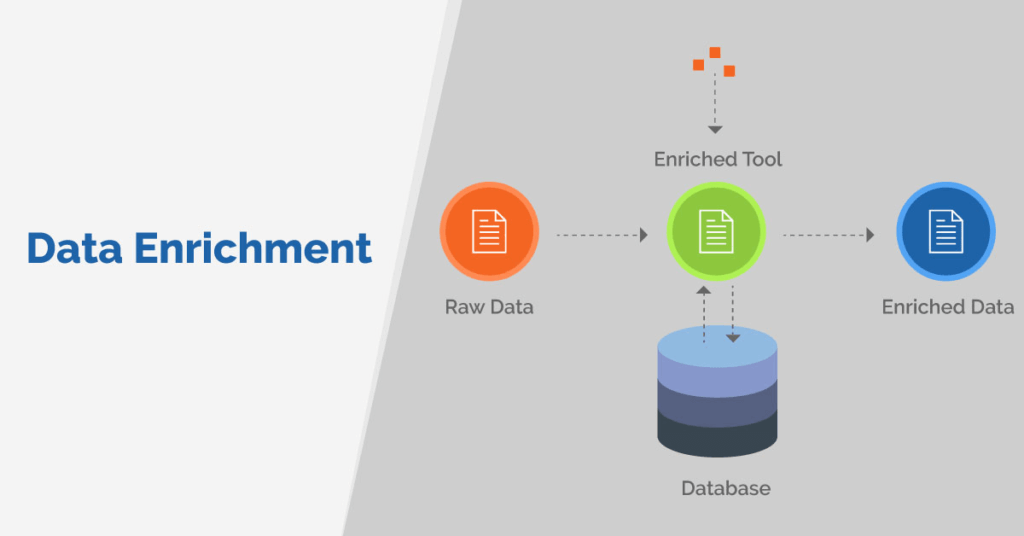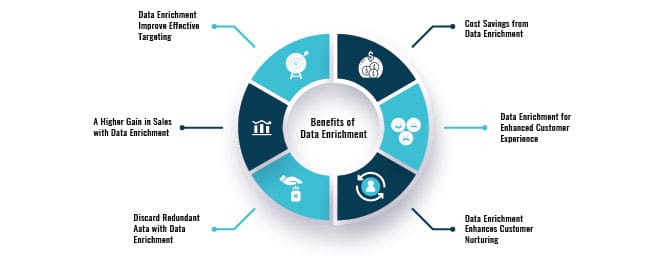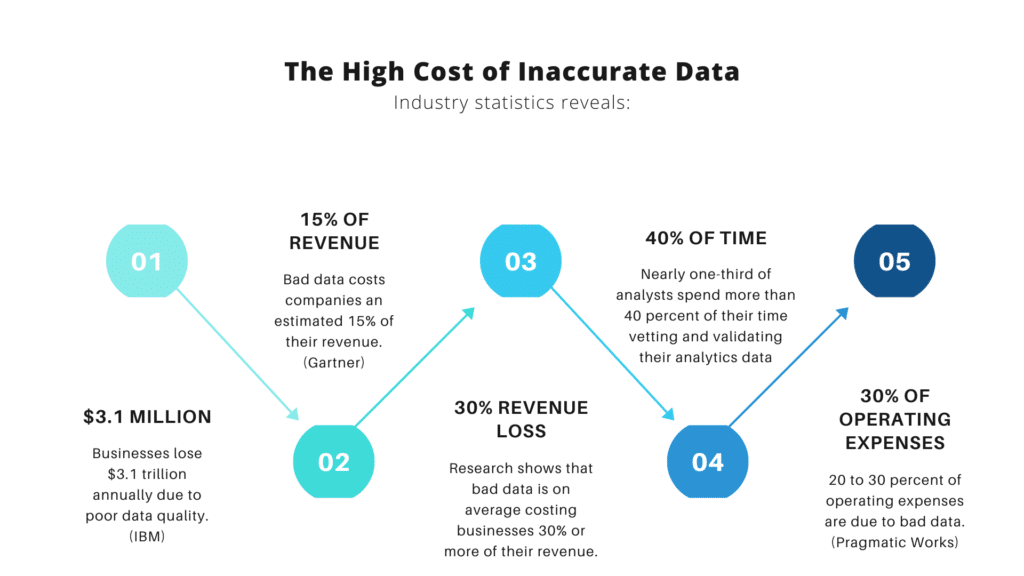What is Data Enrichment, and How to Use Data Enrichment Tools

While there may be bountiful customer data sources all around us, it’s not always easy to find meaningful signals amidst all the noise. The accuracy and relevance of data are a significant concern. 72% of organizations are convinced that data quality issues affect how their customers trust and perceive them. Rich, high-quality customer data is needed for your sales team to make deep customer connections that convert.
While basic tools like lead capture forms can help you amass reliably accurate data, the challenge is filling in the additional details that get you inside the customer’s mindset. The process of gathering and vetting this deeper information is called data enrichment. Fortunately for marketing and sales teams, a diverse array of data enrichment tools exist to help understand prospects better.
This post will cover the essentials of data enrichment and its associated tools and provide five examples of how to use data enrichment tools to your best advantage.
What is data enrichment?
Data enrichment is a method for improving the quality of your existing data by keeping it up to date, checking it for accuracy, and appending additional information from internal and external sources. When applied to customer data, data enrichment aims to build more detailed and accurate customer and contact profiles in your CRM. It does this by filling in details in multiple categories, such as demographic, geographical, behavioral, and firmographics.
In B2B sales, the purchasing process is long, and multiple stakeholders may need convincing. Under these conditions, knowing your customer is critical. Buyers are nearly three times more likely to have an easy purchasing experience when they can access helpful information. You need detailed, reliable data on the buyers and their organizations to know what their challenges are, what they’re looking for, and what information will count as helpful.

There are several subcategories of data enrichment. Key types include:
- Demographic data enrichment relates to information about individual customers. In a B2B context, this would be the decision-makers within the target organization.
- Geographic data enrichment involves where the customer is located and how regional factors might influence their purchasing process.
- Lead enrichment involves tracking the activity of prospective customers to build more detailed profiles and identify where they are in their buyer’s journey.
- Account enrichment is similar to lead enrichment, but it focuses on the overall account data (to support account-based marketing efforts) instead of individual leads.
Many businesses use a CRM as the central repository for their customer data, so most data enrichment initiatives focus on the CRM as the primary raw data source to augment and improve.
Benefits of Data Enrichment
The main benefit of data enrichment is access to fuller, more detailed, and accurate information about your customers. Enriched data can be used to improve personalization, segmentation, and automation efforts along your sales funnel.
You can target your marketing materials more precisely and develop more reliable lead scoring methodologies with high-quality data at your disposal. By leveraging your enriched data to create better, more compelling experiences and messaging, you’ll be able to improve your lead nurturing efforts and forge stronger relationships with your existing customers.

A significant side benefit is that you’ll be able to save resources by purging outdated, inaccurate, and useless data.
When data enrichment is functioning as intended, you should be able to market more effectively, close more deals, and reduce the time you spend managing unhelpful data — which should all add up to increased ROI.
What are data enrichment tools?
Engaging in manual data enrichment is possible – if you’re willing to pore over hundreds of LinkedIn profiles and Google search results pages. It’s easier, faster, and more effective to use a software tool. There are lots of ways to go about data enrichment and, consequently, many varieties of tools.
There are three main categories of data enrichment tools:
- CRM-based tools are designed to collect data from external and internal sources, connect to your CRM (usually through an API), and update records stored by removing inaccuracies and adding missing information.
- Customer Data Platforms (CDP) automatically create customer profiles based on data collected from sources throughout your organization. A CDP is useful if some of your teams or software systems deal with customer data that isn’t mirrored in your CRM. A CDP will organize this data and make sure it is accurate and accessible.
- The last type is the catch-all of Data Enrichment Services. This describes any third-party tool or service that goes out and finds new supplementary data for you, checks the accuracy of your existing data against verified sources, or otherwise updates and enhances the information you have.
Using data enrichment tools ensures that updating occurs on a consistent (or even continuous) basis. They reduce the chances of human errors that introduce inaccuracies or overlook beneficial information.

How to Use Data Enrichment Tools
With so many ways to use data enrichment tools, it’s not always obvious where to start. Here are five use cases that illustrate some of the immediate ways to put data enrichment tools, and the high-quality data they capture, to work growing your business.
1. Capture more leads with shorter forms
It’s challenging to find the proper balance with lead capture forms. The fewer fields there are to fill out, the more likely you are to elicit a conversion — but the tradeoff is that you don’t get much data in exchange. Data enrichment makes shorter forms and easy conversion the obvious choice. This is because once you have the lead’s basic information, you can use data-gathering tools to provide the additional details instead of asking the lead to type them in.
2. Source data based on your ideal customer profile
With a detailed, in-depth model of your ideal customer, you can get a clearer picture of the gaps you need to fill in your actual customer records, and get a better idea of where to source that data. By using data enrichment tools to collect this information, you can refine your ideal customer profile to even greater degrees of specificity. Your marketing and sales teams can use these continuously-improving profiles to inform their strategies for qualifying leads and engaging with them.
3. Score and segment your leads more effectively
The more data available, the more possibilities there are for creating more tightly-focused audience segments. Better segmentation allows for a great deal of personalization and makes it possible to experiment with various forms of targeted outreach. Data enrichment also makes automated lead scoring systems more accurate when assessing whether a lead is a good fit and ready to purchase.
4. Personalize as much as possible
Marketing personalization has grown so prevalent that it’s hard to get somebody’s attention without personalized communication. Data sourced, updated, and verified through enrichment processes gives you the best material to work with. It enables the sending of well-timed messages that speak directly to the interests, challenges, and concerns driving prospects’ purchasing decisions.
5. Create better customer experiences
The higher purpose of data enrichment is to make your customer happy. How? By giving them the information they’re looking for, focusing on topics that matter the most to them, and answering all their questions. Data enrichment tools can take a small kernel of customer information and flesh it out with everything they can find and verify. Full data sets can be leveraged to create memorable customer experiences at every stage of their journey, through all your sales and marketing interactions. Enriched data becomes your key to conclusively proving that you have the solution they’re searching for – and getting them to buy it.
Data Enrichment Is an Ongoing Process
Data enrichment has many benefits to offer B2B sellers to cultivate a substantive and knowledgeable dialogue with the discerning buyers they need to win over. Data enrichment tools both simplify and amplify the process and the results. They are well worth your time and investment when used properly.
Just remember, effective data enrichment isn’t a one-time upgrade. Customer data flows through a river of constant change. Companies grow, merge, and collapse. Key decision-makers switch jobs. Enriched data becomes stale data quickly, so successful data enrichment processes are always ongoing, continuously verifying and updating information.
It’s important to have powerful tools to support ongoing enrichment processes for all customer data classes. Using attribution-based personalization tools like Trendemon can help you accurately monitor one of the most crucial factors — the customer’s progress along their buyer’s journey. Timing is everything, and knowing when the right moment is to deliver the right message will keep your sales pipeline full.